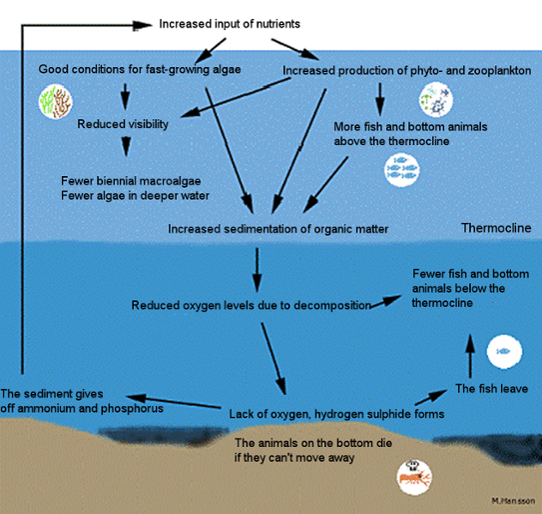The nutrients are the elements needed by photosynthesising organisms (such as plankton) to develop normally. The most important nutrients in the sea are nitrogen and phosphorus. These are often absorbed by organisms when they are in ionic form: phosphorus as phosphate and nitrogen as nitrate, nitrite or ammonium.
One very clear indication of increased levels of nutrients in the sea is the increase in hair-like fast-growing green and red algae. Common seaweed becomes overgrown by the algae hairs and disappears. Eelgrass meadows, which are important nursery habitats for fish, are also badly affected by the hair-like algae.
Over-fertilisation of the sea, or eutrophication as it is also called, is used to imply environmental destruction. However the meaning of eutrophication is really “well-nourished”, from the Greek. An ecosystem can become eutrophic without the system being damaged, i.e. the ecosystem is naturally rich in nutrients.
However eutrophication is usually used as a synonym for over-fertilisation – the system receives too many nutrients so that certain marine species benefit, such as fast-growing algae and certain micro-organisms. These species enjoy the extra nutrients, while other species can disappear.
The effects of over-fertilisation
An increase in the addition of nutrients which are otherwise more limited in the sea has led to an increased production of phytoplankton and zooplankton. This increase provides more food for fish and for animals that live on the bottom if they are in the oxygen-rich water above the thermocline.
Annual, hair-like algae benefit from these conditions, and together with an increase in plankton production lead to a reduction in transparency. When the macroalgae do not get enough light, the mat of seaweed rises closer to the surface.
The increased production above the thermocline means that a lot of organic material falls to the bottom, underneath the thermocline. A lot of oxygen is used as the matter breaks down, and since there is little exchange of water between the layers this can lead to a lack of oxygen.
When the oxygen level drops to below 2 ml/l, the fish leave the area. When all the oxygen has been used up, hydrogen sulphide is formed as the organic matter continues to break down. Hydrogen sulphide is poisonous and kills all animals that live on the sea floor if they cannot escape.
The lack of oxygen causes ammonium and phosphorus to be released from the sediment, which add more nutrients to the sea when they mix with the surface water.
